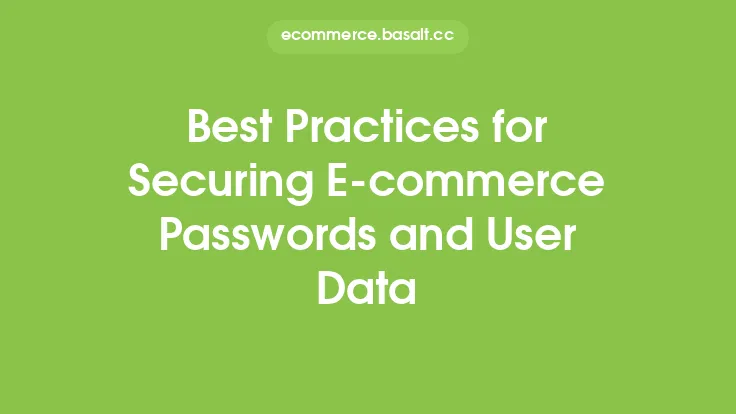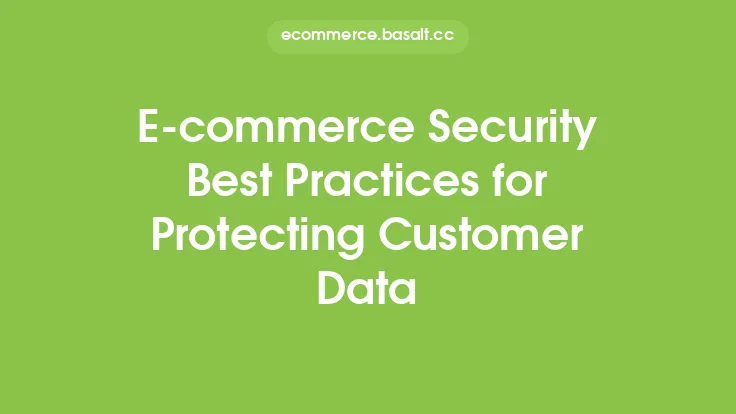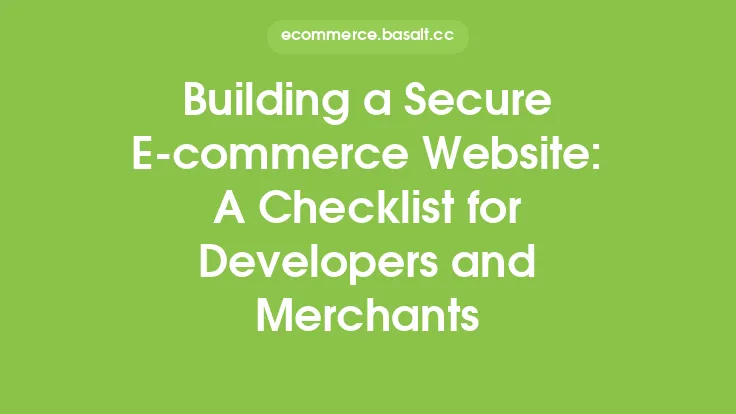Securing e-commerce data is a critical aspect of online business, as it directly impacts the trust and loyalty of customers. With the increasing number of cyber-attacks and data breaches, it's essential for e-commerce businesses to implement robust security measures to protect sensitive information. In this article, we'll delve into the best practices for securing e-commerce data, including encryption, access control, and more.
Introduction to E-commerce Data Security
E-commerce data security refers to the practices and technologies used to protect sensitive information, such as customer personal data, payment information, and business data, from unauthorized access, theft, or damage. This includes data stored on e-commerce websites, mobile apps, and other digital platforms. Effective e-commerce data security is crucial for building trust with customers, preventing financial losses, and maintaining a competitive edge in the market.
Encryption Methods for E-commerce Data
Encryption is a critical component of e-commerce data security, as it converts plaintext data into unreadable ciphertext, making it inaccessible to unauthorized parties. There are several encryption methods used in e-commerce, including:
- Symmetric encryption: Uses the same key for encryption and decryption.
- Asymmetric encryption: Uses a pair of keys, one for encryption and another for decryption.
- Hashing: A one-way encryption method that creates a fixed-size string of characters from input data.
E-commerce businesses should use a combination of these encryption methods to protect different types of data, such as customer passwords, payment information, and sensitive business data.
Access Control and Authentication
Access control and authentication are essential for ensuring that only authorized personnel can access e-commerce data. This includes:
- Implementing strong password policies, such as multi-factor authentication and password rotation.
- Using role-based access control to limit access to sensitive data based on user roles and responsibilities.
- Regularly reviewing and updating access controls to ensure they remain effective and aligned with business needs.
E-commerce businesses should also use secure authentication protocols, such as OAuth and OpenID Connect, to verify user identities and authorize access to sensitive data.
Network Security and Firewalls
Network security and firewalls are critical for protecting e-commerce data from external threats, such as hacking and malware attacks. This includes:
- Implementing a web application firewall (WAF) to detect and prevent common web attacks, such as SQL injection and cross-site scripting (XSS).
- Using a network firewall to control incoming and outgoing traffic based on predetermined security rules.
- Regularly updating and patching network security systems to ensure they remain effective against emerging threats.
E-commerce businesses should also use intrusion detection and prevention systems (IDPS) to monitor network traffic and prevent potential security threats.
Secure Data Storage and Backup
Secure data storage and backup are essential for protecting e-commerce data from loss or corruption. This includes:
- Using secure data storage solutions, such as encrypted databases and secure file systems.
- Implementing regular data backups to prevent data loss in case of a security incident or system failure.
- Using secure data backup and recovery procedures to ensure business continuity in case of a disaster.
E-commerce businesses should also use data loss prevention (DLP) tools to detect and prevent sensitive data from being transmitted or stored outside of authorized systems.
Incident Response and Disaster Recovery
Incident response and disaster recovery are critical for minimizing the impact of a security incident or disaster on e-commerce data. This includes:
- Developing an incident response plan to quickly respond to security incidents, such as data breaches or system compromises.
- Implementing disaster recovery procedures to restore business operations and data access in case of a disaster.
- Regularly testing and updating incident response and disaster recovery plans to ensure they remain effective and aligned with business needs.
E-commerce businesses should also use security information and event management (SIEM) systems to monitor and analyze security-related data from various sources.
Compliance and Regulatory Requirements
Compliance and regulatory requirements are essential for ensuring that e-commerce businesses meet industry standards and regulations for data security. This includes:
- Complying with industry standards, such as PCI DSS and GDPR, to protect sensitive customer data.
- Implementing regulatory requirements, such as HIPAA and CCPA, to protect sensitive business data.
- Regularly reviewing and updating compliance and regulatory requirements to ensure they remain effective and aligned with business needs.
E-commerce businesses should also use compliance and regulatory frameworks, such as NIST and ISO 27001, to guide their data security practices and ensure compliance with industry standards.
Best Practices for E-commerce Data Security
In addition to the security measures mentioned above, e-commerce businesses should follow best practices for e-commerce data security, including:
- Regularly updating and patching software and systems to prevent vulnerabilities.
- Using secure coding practices to prevent common web attacks, such as SQL injection and XSS.
- Implementing secure payment processing procedures to protect sensitive customer data.
- Using secure communication protocols, such as HTTPS and SFTP, to protect data in transit.
- Regularly monitoring and analyzing security-related data to detect and prevent potential security threats.
By following these best practices and implementing robust security measures, e-commerce businesses can protect sensitive customer data, prevent financial losses, and maintain a competitive edge in the market.





